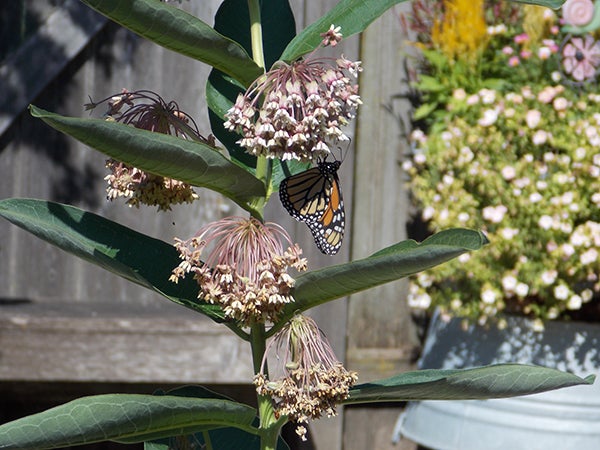Milkweed loss in Midwest could lead to low Monarch population
Published 9:00 am Sunday, March 22, 2015

A monarch butterfly sits on common milkweed, the host plant that it will lay it eggs on. This is the only food that the caterpillar can eat, which is why it is so important to plant milkweed. – Carol Hegel Lang/Albert Lea Tribune
Serendipity Gardens by Carol Hegel Lang
Monarch butterflies will soon be migrating north from their winter homes in central Mexico and coastal California traveling 25 to 30 miles a day. Mexican researchers estimate monarch populations for the winter of 2014 to 2015 in the high elevations of the oyamel fir forests at just over 56 million, which is up 69 percent from the previous year’s estimate of historic lows. This increase certainly does not mean the monarch butterfly has recovered, as this count is one of the lowest ever recorded.
With this information we need to all be aware of what this means to us. One of the biggest threats in the United States is the loss in the Midwest of milkweed, the host plant for the monarch caterpillar. This is especially critical in the Corn Belt areas where farmers have been applying applications of the herbicide glyphosate, or Roundup, killing off milkweed and other native plants growing in the ditches.
Farming practices have changed over the years and farming is now from road to road which eliminates the habitat for wildlife and especially the monarch butterfly.
So what can we gardeners do to help the monarchs? Plant native milkweed in your gardens that includes butterfly weed (asclepias tuberosa), rose milkweed (asclepias incarnate), common milkweed (asclepias syriaca) and whorled milkweed (asclepias verticillata). These milkweed species are pollinator-friendly plants that provide critical food and nectar sources for not only the monarch but also other butterflies.
Cultivate native plants in your gardens to provide nectar sources for all butterflies by planting purple coneflowers, black-eyed Susans and bee balm along with the milkweed. When you plant flowers they should be in large patches of them throughout your gardens so the butterflies can fly from one area to another where there are nectar plants for them. Avoid using pesticides especially systemic insecticides such as neonicotinoids.
Even President Barack Obama has become involved in helping to save and protect our pollinators like bees and monarch butterflies by forming a task force with the U.S. Fish and Wildlife Services reviewing a petition to list the monarch as a threatened species under the U.S. Endangered Species Act. In February 2014 Obama met with Mexico’s president and Canada’s prime minister to form the “Three Amigos” summit, a three-nation group working on the monarch butterfly situation.
The milkweed plant is the host plant where adult butterflies lay their eggs. By growing it in your gardens you are providing this nectar rich source for them. I love smelling the sweet fragrance as I walk through the gardens when they bloom and seeing just how many different insects will flock to them. In my gardens I grow both common milkweed and butterfly weed and they love to self-seed randomly throughout my gardens.
As I mentioned it is also important to provide nectar-rich plants for not just the monarch butterfly but also other butterflies and bees that are pollinators. One of the best plants in my gardens for them is hyssop as bees and butterflies are always on them. A sunny location for herbaceous plants that will provide food for both the adult butterfly and the larval stage can be both beneficial and beautiful.
Asters, lupines, penstemon, rudbeckia, little bluestem and viola are providing food for both adult and larval stages. Coreopsis, baptisa, Joe-pye weed, gillardia, helianthus, heliopsis, liatris, lupines, monarda, phlox, coneflowers, goldenrods, verbena and viola are just a few of the native species that feed the adult butterfly.
Adding a place where butterflies can get sulphur such as a mud puddle is another very important aspect of butterfly gardening. Butterflies are drawn to big and bold splashes of color in purple, red, orange and yellow. Early violets in spring can be a life-saver when little else is blooming. Placing flat stones in a sunny location where they can build up enough body heat to fly and windbreaks to offer shelter from winds are also important to provide. So why not see if you can’t do your part to help save the declining population of monarch butterflies?
“Where have those flowers and butterflies all gone that science may have staked the future on? He seems to say the reason why so much should come to nothing must be fairly faced.” — Robert Frost
Carol Hegel Lang is a green thumb residing in Albert Lea. Her column appears weekly. Email her at carolhegellang@gmail.com.




